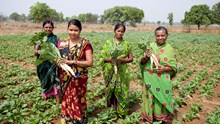
India experiences some of the highest temperatures in the world each year, and with the intensifying effects of climate change, heatwaves have become longer, fiercer, and increasingly deadly. From bustling urban centers to remote rural villages, no region is immune to the soaring heat that can lead to serious health risks such as heat exhaustion, dehydration, and life-threatening heatstroke.
Vulnerable groups, including children, the elderly, pregnant women, and outdoor workers, face the greatest dangers. Prolonged exposure to extreme heat can trigger conditions like heat cramps, heat exhaustion, and, in severe cases, heatstroke. However, with increased awareness and simple lifestyle adjustments, many of these risks can be mitigated, helping to safeguard health and well-being during the hottest months.

Avoid Peak Sunlight Hours
One of the most critical precautions is to remain indoors during the peak sun hours—12:00 noon to 3:00 pm. At this time, the sun's rays are strongest, significantly raising the risk of heat-related illnesses. If going outside is unavoidable, one should wear light, loose-fitting clothing, use an umbrella or a hat for shade, and remain hydrated by drinking water.

Adjust Your Diet to Beat the Heat
Food choices can directly influence how your body handles heat. The advisory does not recommend drinking alcohol, tea, coffee, and carbonated beverages, especially those with a high sugar content. They dry out the body and can disrupt its own cooling system.
In place of these, Individuals are encouraged to drink plain water, fresh juices, buttermilk, lemon water, or coconut water during the day. Meals must be light and ideally vegetarian, and must contain more fresh fruits, salads, and curd. Red meat, which creates more heat during digestion, must be avoided. In addition, it is also important not to eat stale or improperly stored food in summer. The High temperatures can cause food to spoil quickly and lead to foodborne illnesses.

Avoid Cooking During Midday Heat
Cooking during the peak heat hours introduces additional heat into your home environment. Whenever possible, cook early in the morning or late in the evening. Ventilation during cooking can be maintained by opening windows and doors or utilizing exhaust fans to provide means for heat escape. Adequate air flow minimizes indoor temperatures and reduces the potential for heat stress when working in the kitchen.
Never Leave Children or Pets in Parked Vehicles
One of the most dangerous but most neglected heat risks is locking children or pets inside parked cars. Even if the windows are slightly open, the temperature inside a vehicle can rise dangerously fast. This can lead to suffocation or heatstroke in a matter of minutes. Always double-check before locking a vehicle and ensure that no child or pet is left unattended inside.

Don’t Walk Barefoot on Hot Surfaces
Barefoot walking on hot surfaces like roads or outdoor tiles can result in burns and heat build-up in the body. Always wear proper footwear when going outside, particularly during daylight hours. This simple practice can avoid foot injury and minimize heat uptake overall.

Never Leave Children or Pets in Parked Vehicles
One of the most dangerous but most neglected heat risks is locking children or pets inside parked cars. Even if the windows are slightly open, the temperature inside a vehicle can rise dangerously fast. This can lead to suffocation or heatstroke in a matter of minutes. Always double-check before locking a vehicle and ensure that no child or pet is left unattended inside.
What to Do in a Heat Emergency
If a person is confused, faints, has a high fever, or becomes unconscious on a hot day, they might be having heatstroke. If this happens, immediately move the individual to a shaded area or cool location, loosen their clothes, and provide water if the person is awake. Call emergency services to seek medical assistance. Prompt action saves lives. all emergency services at 108 or 102. Timely medical assistance could prevent complications or even deaths resulting from heatstroke.
Building a Culture of Summer Safety
Heatwave safety is not only a personal issue but also a community responsibility. Schools, workplaces, residential societies, and local authorities must work together to create awareness and ensure heat safety measures. Creating shaded rest stops, providing clean drinking water, and adjusting work or school timings on days of extreme heat can be of great help in minimizing risks.
Stay Vigilant, Stay Safe
The Indian summer is hot, but its hazard can be brought down considerably with forearmed and intelligent decision. The Indian summer can be dangerous, but with smart choices, its risks can be minimized. Plan your routines, eat healthily, stay hydrated, and avoid excessive sun exposure. Stay indoors during peak hours and protect vulnerable individuals. Small precautions today lead to a safer, healthier tomorrow. Stay cool and stay safe.
















